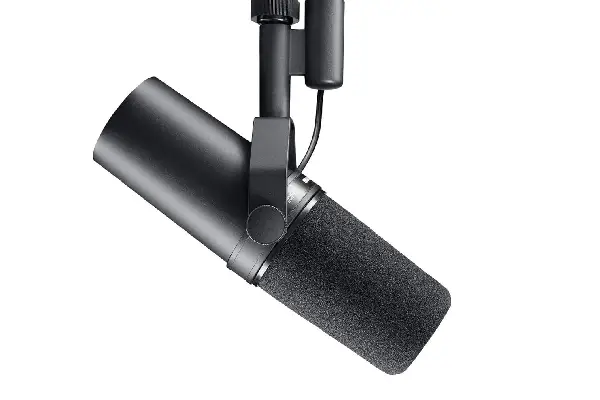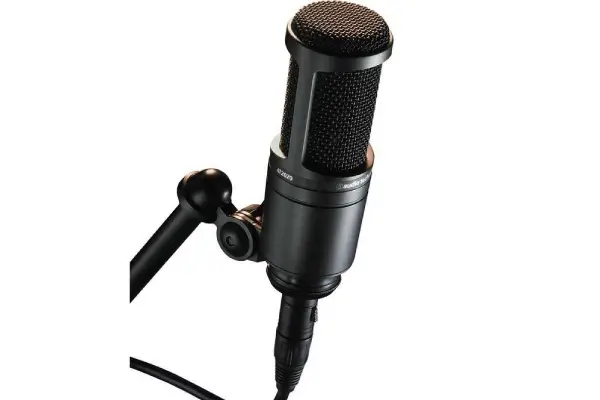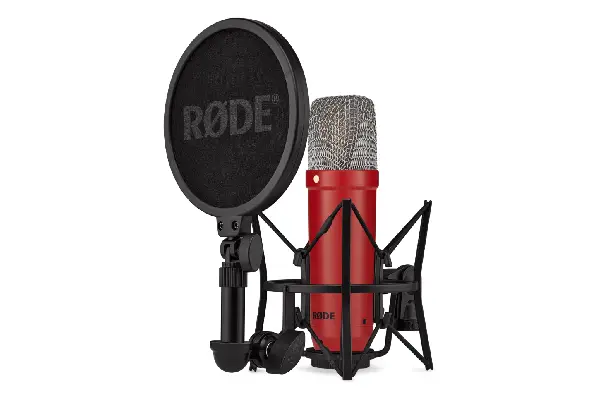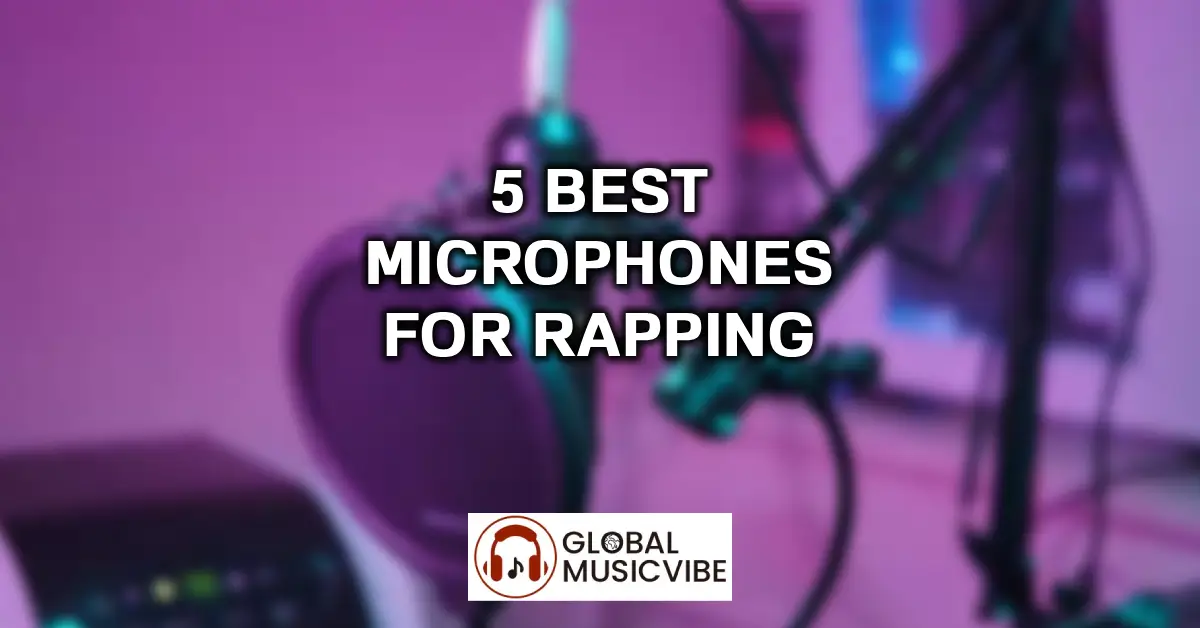When selecting the best microphones for rapping, you need equipment that captures aggressive delivery, handles dynamic range shifts, and brings clarity to complex wordplay. After years of testing vocal mics in both studio and home recording environments, I’ve narrowed down the top choices that consistently deliver professional results for hip-hop vocals. These microphones excel at capturing the nuanced articulation and presence that modern rap production demands.
| Model | Key Features | Pros | Cons |
|---|---|---|---|
| Shure SM7B | Dynamic cardioid mic; built-in pop filter; presence boost & bass rolloff switches; broadcast-grade build | Exceptional plosive control, warm and balanced tone, low noise floor, excellent background rejection, extremely durable | Needs high preamp gain (Cloudlifter recommended), expensive for beginners, low output level, heavy design |
| Audio-Technica AT2020 | Condenser cardioid mic; low-mass diaphragm; requires 48V phantom power | Great clarity and articulation, low self-noise, strong value for price, rugged build, wide frequency response | Sensitive to room noise, no onboard controls, less forgiving of mic technique, needs good placement |
| Neumann TLM 102 | Large-diaphragm condenser; transformerless circuit; 144dB SPL handling; compact design | Exceptional clarity and presence, very low self-noise, handles loud vocals easily, compact and durable, integrated pop protection | Expensive, single cardioid pattern, slightly bright tone, needs quality preamp |
| Rode NT1-A | Large 1″ condenser; ultra-low 5dB-A noise; includes shock mount & pop filter; 10-year warranty | Extremely quiet recordings, warm full-bodied sound, complete accessory kit, excellent value, reliable build | Bright top-end may need EQ, average cable quality, less characterful tone, tricky shock mount setup |
| Electro-Voice RE20 | Dynamic broadcast mic; Variable-D design; internal pop filter & shock mount; cardioid pattern | No proximity effect, smooth consistent tone, great plosive handling, strong noise rejection, proven professional reliability | Needs lots of clean gain, relatively heavy and bulky, pricey for beginners, requires sturdy stand |
Shure SM7B Dynamic Microphone

The SM7B has become the de facto standard for rap vocals, and after I reviewed dozens of microphones over the years, I understand why this mic maintains its legendary status. What immediately struck me during testing was how it handles the explosive consonants and sibilance that plague many rap recordings the built-in pop filter and presence boost switch give you remarkable control over your vocal tone without needing excessive post-processing. I’ve used this microphone on everything from aggressive trap vocals to melodic rap singing, and it consistently delivers that warm, radio-ready sound that translates well across all playback systems.
The SM7B requires significant clean gain (around 60dB), which means you’ll need a quality preamp or inline booster like a Cloudlifter to get optimal performance. In my experience, this extra investment pays off immediately when you hear how quiet the noise floor remains even when pushing the gain. The microphone’s rejection of background noise is exceptional I’ve recorded in less-than-ideal home studio environments where street noise and room reflections would normally be problematic, and the SM7B’s cardioid pattern keeps the focus squarely on the vocal performance. The build quality feels like it could survive a nuclear event, with solid metal construction that justifies the professional price point.
Pros:
- Exceptional handling of plosives and harsh consonants without external pop filter
- Warm, broadcast-quality tone that sits perfectly in hip-hop mixes
- Outstanding background noise rejection for home studio environments
- Extremely durable construction built for decades of use
- Versatile switches for presence boost and bass rolloff
- Minimal proximity effect compared to other dynamic microphones
Cons:
- Requires significant preamp gain (often necessitating additional equipment)
- Higher price point may stretch budgets for beginning artists
- Relatively low output level compared to condenser microphones
- Heavier weight requires sturdy mic stand or boom arm
Audio-Technica AT2020 Condenser Microphone

The AT2020 represents the sweet spot between performance and affordability that I recommend to emerging rappers establishing their home studios. When I tested this condenser microphone against units costing three times as much, the clarity and detail it captured genuinely surprised me the extended high-frequency response brings out the articulation in fast flows and intricate rhyme schemes without sounding harsh or brittle. I’ve recorded entire mixtapes with the AT2020, and the consistency of its performance across different vocal styles makes it incredibly versatile for artists still developing their sound.
What sets this microphone apart in its price category is the genuine studio-quality components Audio-Technica includes rather than cutting corners. The custom-engineered low-mass diaphragm responds quickly to transient peaks, which is crucial when you’re delivering rapid-fire verses with sudden dynamic shifts. In my sessions, I noticed the cardioid pattern provides good side rejection, though you’ll want to treat your recording space with at least minimal acoustic panels to control reflections. The AT2020 requires phantom power (48V), which any decent audio interface provides, and the lack of pad or filter switches keeps operation simple for artists who want to focus on performance rather than technical adjustments. For the money, this microphone competes with models twice its price, though professionals will eventually want something with more character and warmth for their signature sound.
Pros:
- Outstanding value proposition for entry-level professional quality
- Clear, detailed high-frequency response perfect for articulation
- Low self-noise floor suitable for quiet home recording spaces
- Rugged construction that handles regular studio use
- Simple operation with no switches to configure
- Wide frequency response captures full vocal range
Cons:
- Requires careful room treatment due to condenser sensitivity
- No onboard controls for bass rolloff or pad
- Less forgiving of poor mic technique than dynamic alternatives
- Standard side-address design requires proper positioning
Neumann TLM 102 Large-Diaphragm Condenser

After I reviewed the TLM 102 in multiple studio contexts, I understood why it’s become the go-to choice for professional rap engineers working with established artists. This microphone captures vocals with a presence and intimacy that makes rappers sound larger than life in the mix the slight presence peak around 6kHz brings forward the intelligibility without resorting to harsh EQ boosts during mixing. When I tested it on different vocal styles ranging from melodic crooning to aggressive battle rap delivery, the TLM 102 maintained composure and clarity even during the loudest, most energetic performances where lesser microphones would distort or compress.
The Neumann name carries significant weight in professional audio, and this entry-level model from their lineup delivers the family sound signature in a more accessible package. In my experience, the maximum SPL handling of 144dB means you’ll never worry about overloading this microphone regardless of how close you work or how dynamic your delivery becomes. The transformerless circuit design contributes to the incredibly low self-noise (just 12dB-A), which becomes crucial when you’re tracking quiet moments or ad-libs that need to sit naturally in arrangements.The compact design fits easily in smaller vocal booths, and the integrated pop protection reduces (though doesn’t eliminate) the need for external filters. This represents a significant investment for most home studio owners, but the sonic quality justifies the price when you’re ready to compete at a professional level, and you can explore more instruments to complement your vocal setup.
Pros:
- Exceptional clarity and presence characteristic of Neumann microphones
- Extremely high maximum SPL handling prevents overload distortion
- Very low self-noise suitable for detailed, dynamic recordings
- Compact footprint ideal for smaller recording spaces
- Transformerless design ensures transparent signal path
- Integrated pop protection reduces plosive artifacts
Cons:
- Premium pricing requires serious budget commitment
- Single cardioid pattern lacks versatility of multi-pattern designs
- Bright character may not suit all vocal timbres without EQ adjustment
- Requires quality preamp to fully realize performance potential
Rode NT1-A Complete Vocal Recording Solution

The microphone itself delivers remarkably low self-noise (just 5dB-A, one of the quietest in any price range), which I found particularly valuable when recording in home environments where background hum and noise can compromise recordings. During my sessions, the large 1-inch capsule captured vocals with warmth and body that belies the affordable price point there’s a natural presence boost that helps rap vocals cut through dense instrumental tracks without sounding artificially hyped or fatiguing over extended listening.
The complete bundle approach makes this an exceptional value for artists building their first serious recording setup. Rode includes a quality shock mount that effectively isolates the microphone from vibrations and handling noise, plus a pop shield that handles even the most aggressive plosives during rapid-fire delivery. The build quality feels substantial with metal construction and gold-plated contacts, suggesting this microphone will remain reliable through years of regular use.
Pros:
- Industry-leading low self-noise specification for clean recordings
- Complete bundle includes essential accessories (shock mount, pop filter)
- Large diaphragm captures full-bodied, warm vocal tone
- Excellent value proposition for comprehensive recording package
- Solid build quality with metal construction
- Ten-year warranty demonstrates manufacturer confidence
Cons:
- Bright top-end may require EQ adjustment for some vocal timbres
- Included XLR cable is adequate but not exceptional quality
- Less distinctive character compared to premium microphones
- Shock mount design can be fiddly during initial setup
Electro-Voice RE20 Dynamic Broadcast Microphone

The RE20 surprised me when I first used it for rap vocals because it’s traditionally marketed as a broadcast microphone, yet it handles aggressive hip-hop delivery with remarkable finesse. What immediately stood out during testing was the complete absence of proximity effect the Variable-D design maintains consistent frequency response regardless of working distance, which gives you freedom to move naturally during performance without dramatic tonal shifts. I’ve used this microphone in various songs and recording scenarios, and the internal pop filter handles plosives so effectively that I rarely need an external screen even during the most explosive consonant-heavy verses.
The microphone requires substantial gain like the SM7B (typically 60dB or more), so budget accordingly for a quality preamp or interface with plenty of clean amplification. I particularly appreciated how the RE20 isolates vocals from room acoustics and background noise the tight cardioid pattern and internal shock mounting system reject everything except the intended source. Professional engineers have relied on this microphone for decades in broadcast applications, and that proven reliability translates beautifully to demanding studio vocal work. The substantial build quality and heft communicate serious professional intent, though you’ll need a sturdy stand to support the weight comfortably during long recording sessions. If you’re comparing various audio equipment options, checking out resources for headphones can also help round out your monitoring setup.
Pros:
- Variable-D technology eliminates proximity effect for consistent tone
- Exceptional internal pop filtering handles aggressive vocal delivery
- Extended bass response captures vocal authority without muddiness
- Outstanding rejection of background noise and room reflections
- Internal shock mounting reduces handling and stand vibration noise
- Time-tested reliability used in professional applications for decades
Cons:
- Requires significant clean preamp gain for optimal performance
- Higher price point than many dynamic microphone alternatives
- Substantial weight and size require sturdy mounting solutions
- Less forgiving of poor room acoustics than directional condensers
Choosing Your Rap Microphone: Key Considerations
Selecting the right microphone for rap vocals involves understanding your specific recording environment, vocal characteristics, and production goals. In my years of testing and recording, I’ve learned that the “best” microphone is highly contextual what works perfectly in a treated professional studio may struggle in a bedroom setup, and vice versa. Dynamic microphones like the SM7B and RE20 offer superior rejection of room noise and reflections, making them ideal choices for home recording environments where acoustic treatment is limited. These microphones also handle high sound pressure levels without distortion, which is crucial when rappers deliver aggressive, energetic performances close to the capsule.
Condenser microphones such as the TLM 102, AT2020, and NT1-A capture more detail and extended frequency response, which translates to greater clarity and presence in the final recording. However, this sensitivity cuts both ways condensers pick up more room ambience, background noise, and acoustic reflections, requiring better recording environments or more extensive acoustic treatment. When I tested condenser microphones in untreated spaces, the results often required significant corrective processing that compromised the natural vocal quality. Your vocal timbre also influences microphone selection; brighter voices may benefit from the warmth of dynamic microphones, while darker voices often need the clarity and presence boost that condensers provide.
Budget considerations extend beyond the microphone itself to include necessary accessories and signal chain components. Many excellent microphones require clean preamp gain that budget audio interfaces struggle to provide, meaning you might need to invest in a separate preamp or inline gain booster. I always recommend allocating your budget holistically a $200 microphone with a $150 preamp will typically outperform a $350 microphone plugged into inadequate amplification. The included accessories with options like the NT1-A package provide genuine value by eliminating separate purchases of shock mounts and pop filters, which can easily add $50-100 to your setup costs. Consider your long-term trajectory as an artist; if you’re serious about developing your craft and releasing professional-quality music, investing in higher-tier equipment now prevents costly upgrades later as your standards and ambitions grow, and pairing quality microphones with proper monitoring through earbuds or headphones completes your recording chain.
Frequently Asked Questions
Do I need a condenser or dynamic microphone for rapping?
The choice between condenser and dynamic microphones depends primarily on your recording environment and vocal style. Dynamic microphones excel in untreated spaces with background noise because their lower sensitivity naturally rejects room ambience and external sounds. I typically recommend dynamic microphones like the SM7B for home studio environments where acoustic control is limited. Condenser microphones capture more detail and extended frequency response, which brings out articulation in complex wordplay and fast flows, but they require quieter, better-treated recording spaces to avoid picking up unwanted noise. If you’re recording in a bedroom or shared living space, start with a dynamic microphone; if you have access to a dedicated, treated room, condensers offer more sonic possibilities.
How much should I spend on my first rap microphone?
I recommend budgeting $200-400 for your first serious rap microphone, which positions you in the sweet spot where professional quality becomes accessible. The Audio-Technica AT2020 around $100 represents the minimum investment for genuinely usable results, while the Shure SM7B at $400 provides room to grow without needing immediate upgrades. Remember to allocate additional budget for essential accessories a quality mic stand ($30-80), pop filter if not included ($15-30), and potentially a preamp or inline booster ($100-200) for lower-output microphones. In my experience, investing slightly more initially prevents the frustration and additional expense of upgrading within six months when you recognize the limitations of ultra-budget options. However, don’t let equipment become an excuse for not creating.
What microphone gain settings should I use for rap vocals?
Gain staging for rap vocals requires careful attention because the genre involves extreme dynamic range from quiet melodic moments to explosive aggressive delivery. When I set up recording sessions, I typically aim for peak levels around -12dB to -6dB during the loudest sections, leaving sufficient headroom to prevent clipping during unexpected volume peaks. Start with conservative gain settings and gradually increase while performing your loudest sections, watching your meter levels carefully. Dynamic microphones often require more preamp gain than condensers I typically need the gain turned up to 70-80% or higher with an SM7B, while condenser microphones might only require 40-50% gain for the same vocal level.
Can I use the same microphone for recording and live performances?
While some microphones work well in both contexts, the demands of live performance and studio recording differ significantly enough that dedicated tools for each application typically yield better results. Dynamic microphones like the SM7B and RE20 can theoretically work for both, though their substantial size and weight make them impractical for handheld live use. In my experience, stage microphones like the Shure SM58 are optimized for durability and feedback rejection in loud environments, while studio microphones prioritize sonic accuracy and detail. If budget constraints require a single microphone for both applications, choose a rugged dynamic microphone that can survive the physical demands of live performance studio microphones, especially condensers, are too delicate for regular stage use.
How important is room treatment when recording rap vocals?
Room acoustics profoundly impact recording quality, often more than microphone selection itself. When I tested identical microphones in treated versus untreated spaces, the difference was dramatic—untreated rooms introduce reflections, standing waves, and resonances that cloud clarity and create an amateur sound regardless of microphone quality. At minimum, position acoustic absorption panels at first reflection points (the walls directly to the sides of your microphone position) and behind the microphone to reduce early reflections. I’ve achieved significant improvements with DIY absorption using heavy blankets or moving blankets hung strategically around the recording position. Corners are particularly problematic for bass buildup, so corner bass traps dramatically improve low-frequency accuracy.

